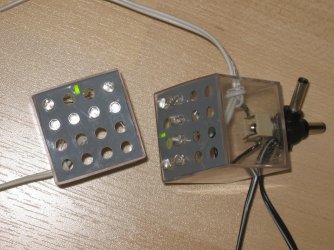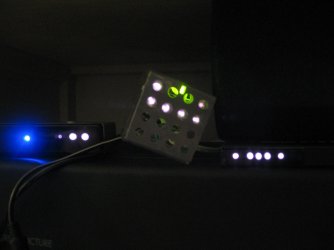Summary: The pointing distance limit of a wireless sensor bar is around 12 times the distance between the two groups of InfraRed LEDs at the two ends of the sensor bar.
Problem:
I am playing Wii with a projector half of the time. The projected image is usually between 60 and 80 inches (diagonal). I bought a Nyko wireless sensor bar but I was very disappointed by the distance limit when playing Rayman Raving Rabbids. It keeps telling me to get closer to the TV. This really makes it difficult to play Wii on a very large screen at a distance. In both the original sensor bar and the Nyko wireless one, the distance between the left and right IR LED is around 8-9 inches. The fact that the WiiMote can see the IR from a longer distance during calibration (though not much longer) made me suspect the problem being the spatial resolution of the two groups of IR by the WiiMote.
Solution:
I got a 20 pack IR LEDs from Dealextreme for $2.90 shipped. For each side, I connected 6 of them and a green LED in serial and put in a 1.75"x1.75"x1.75" plastic box. I don't think you need that many IR LEDs but this will ensure a stronger IR signal to be detected at a longer distance and a total of 7 LEDs eliminated the need of resistor when it is connected to a 9V DC power adapter (~1.2V drop per LED). I made 2 of this LED lamp boxes (sensor cubes) and place them at various distance. First, I tried the sensitivity calibration. Surprisingly, I found the signal strength from these "wireless sensor cubes" to be just on par with the the original sensor bar even they have 3 times the number of LED. It gives around 22 feet of detection limit (before it starts blinking in maximum calibration setting). Nevertheless, through a digital camera viewer, the 6-LED sensor cubes showed a stronger intensity than the Nyko wireless sensor bar. I think the LED I got has a shorter emission wavelength. Even the intensity is higher, it was not detected by the WiiMote with higher sensitivity. More LED may be needed if you need to play Wii at a distance longer than 20-25 ft from the sensor. As for the pointing sensitivity test (spatial resolution of the 2 IR LED groups), I found placing the 2 sensor cubes farther apart gives me longer functional pointing distance. There is roughly a factor of 12 (i.e. placing them 10" apart and the WiiMote pointer works up to around 10 ft). With the original sensor bar, the resolution of the 2 IR groups limits the gaming distance in Rayman Raving Rabbids to less than 8 ft. It was very annoying keep seeing that "Get Closer to Your TV" message blinking from time to time. With the homemake sensor cubes placed 16" apart, I can play the same game up to 18ft away. I've tested up to 24" and I can play up to 22-25ft where it is limited by the IR signal intensity.
More test:
One last thing is to test the optimal ratio in the distance between the 2 IR LED groups and the screen size. This is critical for shooting game using one of those gun adapter that you want to line up your WiiMote with the onscreen pointer. I found if the sensor cubes are placed around 1/4 of the width of the screen (not diagonally measured), then the WiiMote points almost right at the pointer on screen from side to side. I tested it with the shooting game in WiiPlay. In other words, the original sensor bar is best for a 37"-42" TV. For an 84" projection screen, one should place the sensor cubes (IR LED lamps) at ~16" apart. The actual point angle would depends on how far away are you sitting/standing from the screen. Using 2 separated IR LED sources allows you fine tune the pointing angle to improve gaming experience.
Final words:
I also tested the IR LED lamps with a regular 9V battery, but the signal was too weak. Therefore, I have to use a DC adapter and I put a 3.5mm port on the box for that. I have tried using a retractable wire from a USB cable thinking that would be neat to have adjustable distance between the 2 lamps and use only 1 DC adapter. It turned out that the wires inside the retractable cord are too thin (high resistance) and the coating made it hard to solder. I ended up using an audio cable from a desktop speaker to connect the sensor cubes. You may want to get slightly thinner cable to connect the 2 boxes. My cable is too heavy that keep dragging the box and change the orientation of the boxes.
:aureola:
Problem:
I am playing Wii with a projector half of the time. The projected image is usually between 60 and 80 inches (diagonal). I bought a Nyko wireless sensor bar but I was very disappointed by the distance limit when playing Rayman Raving Rabbids. It keeps telling me to get closer to the TV. This really makes it difficult to play Wii on a very large screen at a distance. In both the original sensor bar and the Nyko wireless one, the distance between the left and right IR LED is around 8-9 inches. The fact that the WiiMote can see the IR from a longer distance during calibration (though not much longer) made me suspect the problem being the spatial resolution of the two groups of IR by the WiiMote.
Solution:
I got a 20 pack IR LEDs from Dealextreme for $2.90 shipped. For each side, I connected 6 of them and a green LED in serial and put in a 1.75"x1.75"x1.75" plastic box. I don't think you need that many IR LEDs but this will ensure a stronger IR signal to be detected at a longer distance and a total of 7 LEDs eliminated the need of resistor when it is connected to a 9V DC power adapter (~1.2V drop per LED). I made 2 of this LED lamp boxes (sensor cubes) and place them at various distance. First, I tried the sensitivity calibration. Surprisingly, I found the signal strength from these "wireless sensor cubes" to be just on par with the the original sensor bar even they have 3 times the number of LED. It gives around 22 feet of detection limit (before it starts blinking in maximum calibration setting). Nevertheless, through a digital camera viewer, the 6-LED sensor cubes showed a stronger intensity than the Nyko wireless sensor bar. I think the LED I got has a shorter emission wavelength. Even the intensity is higher, it was not detected by the WiiMote with higher sensitivity. More LED may be needed if you need to play Wii at a distance longer than 20-25 ft from the sensor. As for the pointing sensitivity test (spatial resolution of the 2 IR LED groups), I found placing the 2 sensor cubes farther apart gives me longer functional pointing distance. There is roughly a factor of 12 (i.e. placing them 10" apart and the WiiMote pointer works up to around 10 ft). With the original sensor bar, the resolution of the 2 IR groups limits the gaming distance in Rayman Raving Rabbids to less than 8 ft. It was very annoying keep seeing that "Get Closer to Your TV" message blinking from time to time. With the homemake sensor cubes placed 16" apart, I can play the same game up to 18ft away. I've tested up to 24" and I can play up to 22-25ft where it is limited by the IR signal intensity.
More test:
One last thing is to test the optimal ratio in the distance between the 2 IR LED groups and the screen size. This is critical for shooting game using one of those gun adapter that you want to line up your WiiMote with the onscreen pointer. I found if the sensor cubes are placed around 1/4 of the width of the screen (not diagonally measured), then the WiiMote points almost right at the pointer on screen from side to side. I tested it with the shooting game in WiiPlay. In other words, the original sensor bar is best for a 37"-42" TV. For an 84" projection screen, one should place the sensor cubes (IR LED lamps) at ~16" apart. The actual point angle would depends on how far away are you sitting/standing from the screen. Using 2 separated IR LED sources allows you fine tune the pointing angle to improve gaming experience.
Final words:
I also tested the IR LED lamps with a regular 9V battery, but the signal was too weak. Therefore, I have to use a DC adapter and I put a 3.5mm port on the box for that. I have tried using a retractable wire from a USB cable thinking that would be neat to have adjustable distance between the 2 lamps and use only 1 DC adapter. It turned out that the wires inside the retractable cord are too thin (high resistance) and the coating made it hard to solder. I ended up using an audio cable from a desktop speaker to connect the sensor cubes. You may want to get slightly thinner cable to connect the 2 boxes. My cable is too heavy that keep dragging the box and change the orientation of the boxes.
:aureola:
Attachments
Last edited:



